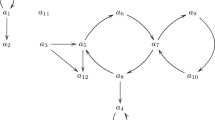Abstract
Reaction systems, motivated by the functioning of the living cell, became a novel model of interactive computation. In this paper, we pursue this line of research. More specifically, we present a systematic investigation of possible interactions of a reaction system with its environment (context). While in the original definition this interaction is one-way, i.e., the behavior of a reaction system is influenced by its environment, we investigate now also the influence of the system on its environment, where a possible time delay of this influence is also considered. To understand the behavior of reaction systems when such a two-way interaction takes place, we establish its relationship to their context-independent behavior (i.e., the behavior which is not influenced by the environment).










Similar content being viewed by others
Notes
Note that \({En}(A,S)=\emptyset\) and \(En(A,\emptyset)=\emptyset\), because for each reaction \(b\in {A}\), both \(I_b\) and \(R_b\) must be nonempty.
We slightly revise the classical definition in [13], where \(D_0=\emptyset\) is also required.
References
Azimi S, Iancu B, Petre I. Reaction system models for the heat shock response. Fundam. Inform. 2014;131(3–4):299–312.
Barbuti R, Gori R, Levi F, Milazzo P. Generalized contexts for reaction systems: definition and study of dynamic causalities. Acta Inf. 2018;55(3):227–67.
Bottoni P, Labella A. Reaction systems with constrained environment. In: CiE 2013, Informal Proceedings. University of Milano Bicocca. 2013.
Brijder R, Ehrenfeucht A, Main MG, Rozenberg G. A tour of reaction systems. Int. J. Found. Comput. Sci. 2011;22(7):1499–517.
Brijder R, Ehrenfeucht A, Rozenberg G. Reaction systems with duration. In computation, cooperation, and life. LNCS. 2011;6610:191–202.
Corolli L, Maj C, Marini F, Besozzi D, Mauri G. An excursion in reaction systems: from computer science to biology. Theor. Comput. Sci. 2012;454:95–108.
Dennunzio A, Formenti E, Manzoni L, Porreca AE. Ancestors, descendants, and gardens of eden in reaction systems. Theor. Comput. Sci. 2015;608:16–26.
Ehrenfeucht A, Kleijn J, Koutny M, Rozenberg G. Minimal reaction systems. Trans. Comp. Syst. Biol. 2012;XIV:102–22.
Ehrenfeucht A, Kleijn J, Koutny M, Rozenberg G. Qualitative and quantitative aspects of a model for processes inspired by the functioning of the living cell. In: Biomolecular Information Processing, pages 303–321. Wiley-Blackwell, 2012.
Ehrenfeucht A, Kleijn J, Koutny M, Rozenberg G. Reaction systems: a natural computing approach to the functioning of living cells. In: Zenil H, editor. A Computable universe; understanding and exploring nature as computation. Singapore: World Scientific; 2012. p. 189–208 (chapter 9).
Ehrenfeucht A, Kleijn J, Koutny M, Rozenberg G. Evolving reaction systems. Theor. Comput. Sci. 2017;682:79–99.
Ehrenfeucht A, Petre I, Rozenberg G. Reaction systems: a model of computation inspired by the functioning of the living cell. In: Konstantinidis S, Moreira N, Reis R, Shallit J, editors. The role of theory in computer science—essays dedicated to Janusz Brzozowski. Singapore: World Scientific; 2017. p. 1–32 (chapter 1).
Ehrenfeucht A, Rozenberg G. Reaction systems. Fundam. Inform. 2007;75(1–4):263–80.
Ehrenfeucht A, Rozenberg G. Zoom structures and reaction systems yield exploration systems. Int. J. Found. Comput. Sci. 2014;25(3):275–306.
Formenti E, Manzoni L, Porreca AE. Cycles and global attractors of reaction systems. In: Helmut Jürgensen, Juhani Karhumäki, and Alexander Okhotin, editors, Descriptional Complexity of Formal Systems—16th International Workshop, DCFS 2014, Turku, Finland, August 5–8, 2014. Proceedings, volume 8614 of LNCS, pages 114–125. Springer, 2014.
Formenti E, Manzoni L, Porreca AE. On the complexity of occurrence and convergence problems in reaction systems. Nat. Comp. 2015;14(1):185–91.
Genova D, Hoogeboom HJ, Jonoska N. A graph isomorphism condition and equivalence of reaction systems. Theor. Comput. Sci. 2017;701:109–19.
Hirvensalo M. On probabilistic and quantum reaction systems. Theor. Comput. Sci. 2012;429:134–43.
Manzoni L, Castelli M, Vanneschi L. Evolutionary reaction systems. In Mario G, Leonardo V, William SB (eds), Evolutionary computation, machine learning and data Mining in bioinformatics—10th European Conference, EvoBIO 2012, Málaga, Spain, April 11-13, 2012. Proceedings, volume 7246 of LNCS, pages 13–25. Springer, 2012.
Meski A, Penczek W, Rozenberg G. Model checking temporal properties of reaction systems. Inf. Sci. 2015;313:22–42.
Salomaa A. Functions and sequences generated by reaction systems. Theor. Comput. Sci. 2012;466:87–96.
Salomaa A. On state sequences defined by reaction systems. In: Robert LC, Alexandra S, editors. Logic and program semantics—essays dedicated to Dexter Kozen on the Occasion of his 60th Birthday, vol. 7230. Berlin: Springer; 2012. p. 271–82.
Salomaa A. Functional constructions between reaction systems and propositional logic. Int. J. Found. Comput. Sci. 2013;24(1):147–60.
Salomaa A. Minimal reaction systems defining subset functions. In: Cristian SC, Rusins F, Kazuo I, editors. Computing with new resources–essays dedicated to Jozef Gruska on the Occasion of his 80th Birthday, vol. 8808. Berlin: Springer; 2014. p. 436–46.
Salomaa A. Two-step simulations of reaction systems by minimal ones. Acta Cybern. 2015;22(2):247–57.
Acknowledgements
The authors are indebted to Robert Brijder and to three anonymous referees for their useful comments concerning this paper. Grzegorz Rozenberg was supported by the Visiting Professor Programme of Sapienza.
Author information
Authors and Affiliations
Corresponding author
Rights and permissions
About this article
Cite this article
Bottoni, P., Labella, A. & Rozenberg, G. Reaction systems with influence on environment. J Membr Comput 1, 3–19 (2019). https://doi.org/10.1007/s41965-018-00005-8
Received:
Accepted:
Published:
Issue Date:
DOI: https://doi.org/10.1007/s41965-018-00005-8




